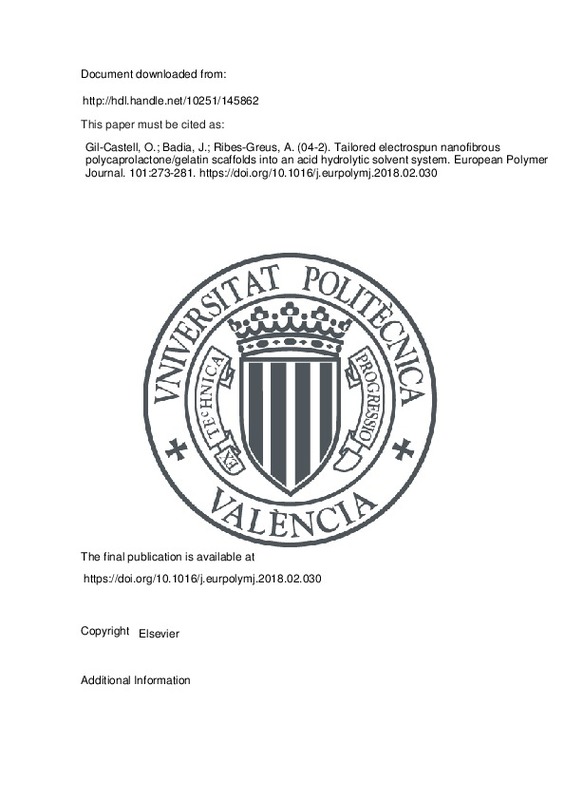JavaScript is disabled for your browser. Some features of this site may not work without it.
Buscar en RiuNet
Listar
Mi cuenta
Estadísticas
Ayuda RiuNet
Admin. UPV
Tailored electrospun nanofibrous polycaprolactone/gelatin scaffolds into an acid hydrolytic solvent system
Mostrar el registro sencillo del ítem
Ficheros en el ítem
| dc.contributor.author | Gil-Castell, O.
|
es_ES |
| dc.contributor.author | Badia, J.D.
|
es_ES |
| dc.contributor.author | Ribes-Greus, A.
|
es_ES |
| dc.date.accessioned | 2020-06-10T03:32:16Z | |
| dc.date.available | 2020-06-10T03:32:16Z | |
| dc.date.issued | 2018-04 | es_ES |
| dc.identifier.issn | 0014-3057 | es_ES |
| dc.identifier.uri | http://hdl.handle.net/10251/145862 | |
| dc.description.abstract | [EN] Blended nanofibrous scaffolds based on polycaprolactone (PCL) and gelatin (Ge) were successfully prepared. A formic/acetic acid (1:1) mixture was used to dissolve PCL/Ge blends from 100/0 to 20/80 %wt in steps of 10 %wt. The hydrolysis of the PCL diluted in the formic/acetic acid mixture was considered as a method for tailoring the surface morphology and physicochemical features of the nanofibrous PCL/Ge scaffolds as a function of the dissolution time. The fibre diameter remained in the nanoscale range for all the studied scaffolds, which is crucial to mimic the extra-cellular matrix size. The reduction of the intrinsic viscosity, molar mass and hydrodynamic radius found for the PCL molecules as a function of the dissolution time, consequently diminished the entanglement capability of the polymeric chains. Subsequently, the fibre diameter decreased as dissolution time increased, for all the studied compositions. While the crystallinity of the scaffolds with high PCL content increased as a function of the dissolution time, the scaffolds with high percentage of Ge showed the lowest crystallinity degree, which was ascribed to the hindering effect of the Ge diffused among the PCL segments. The wettability increased as a function of the Ge content due to the high hydrophilic behaviour of these molecules. It also increased as a function of the dissolution time, due to the more hydroxyl groups available in PCL segments to interact with water molecules. As a whole, the physicochemical assessment of the electrospun scaffolds revealed an effective tailoring procedure to obtain functionalised PCL/Ge scaffolds with specific properties as a function of the dissolution time before electrospinning. | es_ES |
| dc.description.sponsorship | The Spanish Ministry of Economy and Competitiveness is acknowledged for the projects POLYCELL (ENE2014-53734-C2-1-R), POLYDECARBOCELL (ENE2017-86711-C3-1-R) and UPOV13-3E-1947. The Spanish Ministry of Education, Culture and Sports is thanked for the pre-doctoral FPU grant of O. Gil-Castell (FPU13/01916). Generalitat Valenciana is thanked for the APOSTD/2014/041 for J.D. Badia. | es_ES |
| dc.language | Inglés | es_ES |
| dc.publisher | Elsevier | es_ES |
| dc.relation.ispartof | European Polymer Journal | es_ES |
| dc.rights | Reserva de todos los derechos | es_ES |
| dc.subject | Electrospinning | es_ES |
| dc.subject | Scaffold | es_ES |
| dc.subject | Polycaprolactone (PCL) | es_ES |
| dc.subject | Gelatin (Ge) | es_ES |
| dc.subject | Tailoring | es_ES |
| dc.subject | Hydrolysis | es_ES |
| dc.subject.classification | CIENCIA DE LOS MATERIALES E INGENIERIA METALURGICA | es_ES |
| dc.subject.classification | MAQUINAS Y MOTORES TERMICOS | es_ES |
| dc.title | Tailored electrospun nanofibrous polycaprolactone/gelatin scaffolds into an acid hydrolytic solvent system | es_ES |
| dc.type | Artículo | es_ES |
| dc.identifier.doi | 10.1016/j.eurpolymj.2018.02.030 | es_ES |
| dc.relation.projectID | info:eu-repo/grantAgreement/MINECO//UPOV13-3E-1947/ES/Cromatrografía por Exclusión de Tamaños/ | es_ES |
| dc.relation.projectID | info:eu-repo/grantAgreement/GVA//APOSTD%2F2014%2F041/ | es_ES |
| dc.relation.projectID | info:eu-repo/grantAgreement/MECD//FPU13%2F01916/ES/FPU13%2F01916/ | es_ES |
| dc.relation.projectID | info:eu-repo/grantAgreement/MINECO//ENE2014-53734-C2-1-R/ES/DISEÑO Y VALIDACION DE MEMBRANAS CON CONTROL MORFOLOGICO PARA SU USO EN PILAS DE COMBUSTIBLE DE BAJA TEMPERATURA SOSTENIBLES EN VEHICULOS EFICIENTES NO TRIPULADOS/ | es_ES |
| dc.relation.projectID | info:eu-repo/grantAgreement/CORFO//13CEI2-21839/ | es_ES |
| dc.relation.projectID | info:eu-repo/grantAgreement/AEI/Plan Estatal de Investigación Científica y Técnica y de Innovación 2013-2016/ENE2017-86711-C3-1-R/ES/SISTEMA INTEGRADO DE DESCARBONIZACION Y PRODUCCION DE ENERGIA BASADO EN PILAS DE COMBUSTIBLE DE METANOL DIRECTO PARA APLICACIONES NAVALES Y AEROESPACIALES/ | es_ES |
| dc.rights.accessRights | Abierto | es_ES |
| dc.contributor.affiliation | Universitat Politècnica de València. Departamento de Máquinas y Motores Térmicos - Departament de Màquines i Motors Tèrmics | es_ES |
| dc.contributor.affiliation | Universitat Politècnica de València. Instituto de Tecnología de Materiales - Institut de Tecnologia de Materials | es_ES |
| dc.description.bibliographicCitation | Gil-Castell, O.; Badia, J.; Ribes-Greus, A. (2018). Tailored electrospun nanofibrous polycaprolactone/gelatin scaffolds into an acid hydrolytic solvent system. European Polymer Journal. 101:273-281. https://doi.org/10.1016/j.eurpolymj.2018.02.030 | es_ES |
| dc.description.accrualMethod | S | es_ES |
| dc.relation.publisherversion | https://doi.org/10.1016/j.eurpolymj.2018.02.030 | es_ES |
| dc.description.upvformatpinicio | 273 | es_ES |
| dc.description.upvformatpfin | 281 | es_ES |
| dc.type.version | info:eu-repo/semantics/publishedVersion | es_ES |
| dc.description.volume | 101 | es_ES |
| dc.relation.pasarela | S\355789 | es_ES |
| dc.contributor.funder | Generalitat Valenciana | es_ES |
| dc.contributor.funder | Agencia Estatal de Investigación | es_ES |
| dc.contributor.funder | Ministerio de Economía y Competitividad | es_ES |
| dc.contributor.funder | Corporación de Fomento de la Producción, Chile | es_ES |
| dc.contributor.funder | Ministerio de Educación, Cultura y Deporte | es_ES |







![[Cerrado]](/themes/UPV/images/candado.png)

